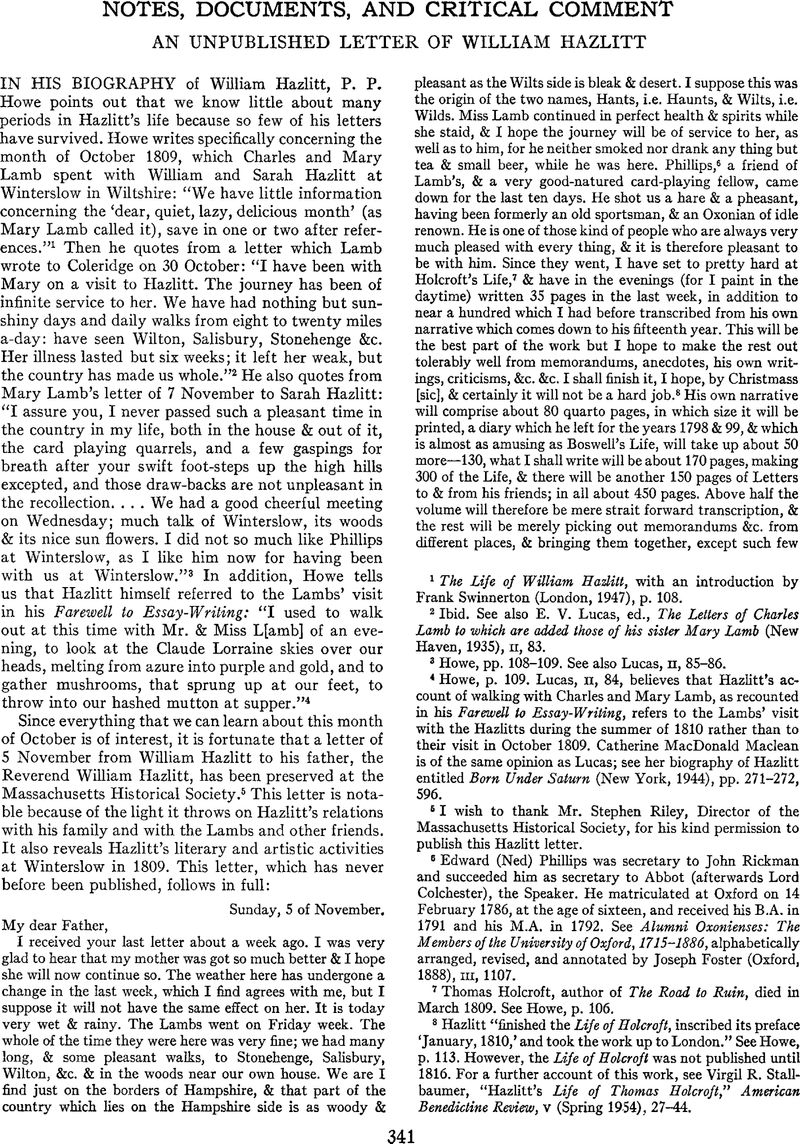No CrossRef data available.
Article contents
An Unpublished Letter of William Hazlitt
Published online by Cambridge University Press: 02 December 2020
Abstract

- Type
- Notes, Documents, and Critical Comment
- Information
- Copyright
- Copyright © Modern Language Association of America, 1962
References
Note 1 in page 341 The Life of William Hazlitt, with an introduction by Frank Swinnerton (London, 1947), p. 108.
Note 2 in page 341 Ibid. See also E. V. Lucas, ed., The Letters of Charles Lamb to which are added those of his sister Mary Lamb (New Haven, 1935), ii, 83.
Note 3 in page 341 Howe, pp. 108–109. See also Lucas, ii, 85–86.
Note 4 in page 341 Howe, p. 109. Lucas, ii, 84, believes that Hazlitt's account of walking with Charles and Mary Lamb, as recounted in his Farewell to Essay-Writing, refers to the Lambs' visit with the Hazlitts during the summer of 1810 rather than to their visit in October 1809. Catherine MacDonald Maclean is of the same opinion as Lucas; see her biography of Hazlitt entitled Born Under Saturn (New York, 1944), pp. 271–272, 596.
Note 5 in page 341 I wish to thank Mr. Stephen Riley, Director of the Massachusetts Historical Society, for his kind permission to publish this Hazlitt letter.
Note 6 in page 341 Edward (Ned) Phillips was secretary to John Rickman and succeeded him as secretary to Abbot (afterwards Lord Colchester), the Speaker. He matriculated at Oxford on 14 February 1786, at the age of sixteen, and received his B.A. in 1791 and his M.A. in 1792. See Alumni Oxonienses: The Members of the University of Oxford, 1715–1886, alphabetically arranged, revised, and annotated by Joseph Foster (Oxford, 1888), iii, 1107.
Note 7 in page 341 Thomas Holcroft, author of The Road to Ruin, died in March 1809. See Howe, p. 106.
Note 8 in page 341 Hazlitt “finished the Life of Holcroft, inscribed its preface ‘January, 1810,‘ and took the work up to London.” See Howe, p. 113. However, the Life of Holcroft was not published until 1816. For a further account of this work, see Virgil R. Stall-baumer, “Hazlitt's Life of Thomas Holcroft,” American Benedictine Review, v (Spring 1954), 27–44.
Note 9 in page 342 A New and Improved Grammar of the English Tongue, for the Use of Schools was published in November 1809. See Howe, p. 110.
Note 10 in page 342 Joseph Swanwick, of Wem, Shropshire, had been a classmate of Hazlitt's at Hackney College. See W. C. Hazlitt, The Hazlitts: An Account of Their Origin and Descent (Edinburgh, 1911), pp. 385, 393, 399, 401, 405–406.
Note 11 in page 342 Apparently “old Swanwick” was the father of Joseph Swanwick and a member of the Reverend William Hazlitt's congregation at Wem.
Note 12 in page 342 William's sister, Margaret Hazlitt.
Note 13 in page 342 William's older brother.
Note 14 in page 342 The letter is addressed: “Revd. W. Hazlitt Wem Shropshire Single”; two stamped postmarks: “ANDOVER [Nov. ?] 6” and “E NOV 7 1809.”
Note 15 in page 342 Augustine Birrell, William Hazlitt (London, 1902), p. 143.
Note 16 in page 342 This child died on 5 July 1809. See Howe, p. 108.
Note 17 in page 342 Mr. Baring Wall, M. P.
Note 18 in page 342 Margaret Hazlitt's “Recollections”
Note 1 in page 342 Finnegans Wake (New York, 1939), p. 211.
Note 2 in page 342 Richard Ellmann, James Joyce (New York, 1959), p. 570; Edwin Wolf, 2nd, with John F. Fleming, Rosenbach (Cleveland, 1960), pp. 189–191. Wolf and Fleming give the sale price as $1950.
Note 3 in page 343 Wolf and Fleming, pp. 289–290.
Note 4 in page 342 See Joyce, Letters, ed. Stuart Gilbert (New York, 1957), pp. 209, 211, 214, 219.
Note 5 in page 342 Anna Livia Plurabelle: The Making of a Chapter (Minneapolis, 1960), p. 43, hereafter cited as ALP.
Note 6 in page 342 Referring to the Ulysses manuscript contretemps in a letter of 24 May 1924 to Miss Weaver, Joyce puts the same idea in a snatch of doggerel:
Rosy Brook he bought a book
Though he didn't know how to spell it.
Such is the lure of literature
To the lad who can buy it and sell it.
(Letters, p. 214.)
Note 7 in page 342 ALP, p. 16.
Note 8 in page 342 Adaline Glasheen, A Census of Finnegans Wake (Evanston, Ill., 1956), p. 18. Thanks are due to Mrs. Glasheen for her assistance with this passage.
Note 9 in page 342 ALP, p. 44.
Note 10 in page 342 Ibid., p. 17.
Note 11 in page 342 George Neilson, “Caudatus Anglicus: A Mediaeval Slander,” Transactions of the Glasgow Archaeological Society, new ser. ii (1896), 441–477.
Note 12 in page 342 Who, according to Bede, exclaimed, “Non Angli sed angeli” on seeing his first Englishmen.
Note 13 in page 342 See Joshua Trachtenberg, The Devil and the Jews: The Medieval Conception of the Jew and Its Relation to Modern Antisemitism (New Haven, 1943), p. 46.
Note 14 in page 342 In fact Joyce seemed a little incredulous at the title. In a letter to Quinn just three weeks after the sale he refers to “Mr (or Dr) Rosenbach,” and writing to Miss Weaver a few days later Joyce again uses “Mr” (Letters, pp. 209, 211).
Note 15 in page 342 Maggi (then spelled Maggy) first enters in the third draft (ALP, p. 44) and Browne but Nolan in the fourth (ALP, p. 56).
Note 16 in page 342 Glasheen, p. 18. However, Mrs. Glasheen is in error in stating that Browne and Nolan published The Day of the Rabblement.
Note 17 in page 342 ALP, p. 74.
Note 18 in page 342 Sylvia Beach, Shakespeare and Company (New York, 1959), p. 85.
Note 19 in page 344 DNB, Supplement 1901–1911.
Note 20 in page 342 Cradles are also associated with the name Coppinger at Finnegans Wake, p. 329 (“a copener's cribful”).




